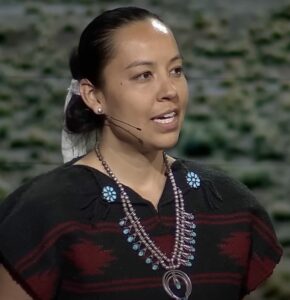Anthropolgist with indigenous roots says flooding need not be a danger for humans and their environment.
By Della Hale
Original Air Date: September 25, 2024
Host: Hundreds of flooded homeowners in our region already know it through experience: Extreme weather events are no longer anomalies but increasingly frequent harbingers of our changing climate. The rise in water levels serves as a stark reminder that the impacts of climate change are not distant predictions but happening right now. WSLR News reporter Della Hale talked to an anthropologist who has been working along the lines of human behavior in a changing climate, and got some hands-on advice. Dr. Lyla June Johnston was going to speak at an event planned for this Friday and Saturday in Sarasota. But — sign of the times — the event had to be postponed due to Hurricane Helene.
Della Hale: The “Earth’s Tapestry” event in Sarasota really has something to say about climate change, but — for now — it was silenced by the pending storm. The event, in part hosted by the Fogartyville Community Center, focuses on people coming back to alignment with nature and aims to educate on the dangers of our changing climate. I had the opportunity to meet with one of the main speakers of the event. Dr. Lyla June Johnston is a California-based anthropologist with Navajo and Cheyenne lineage. Known for her work in environmental advocacy and indigenous rights, she emphasizes the importance of local engagement in tackling climate challenges.

Lyla June Johnston
When asked about solutions to rising sea levels and the increasing frequency of thousand-year storms, she shared insights about adaptive strategies.
Lyla June Johnston: Indigenous groups around the world, they actually turn floods to their advantage by creating systems where those influxes of water actually support food systems. So for example, there’s a floodplain in Bolivia that every time the rainy season comes, they create earthworks to move the water in certain locations. And so as the dry season comes, they capture all the rainy season water into reservoirs and canals and causeways, and through that they create a perennial supply of fish, because even in the dry season, they have these pools. So there may be some opportunities to leverage ancient indigenous wisdom to turn this problem into a solution. Of course that would require a ton of infrastructure, build out, and creative design.
DH: Johnston also had practical advice about keeping roads clean so that our oceans become less polluted as an effect of flooding.
LJJ: Us being ready to nourish the ocean when it floods; us being nourished by floods and the ocean also being nourished. Because right now they’re not nourished by floods, they get an injection of pollutants every time it rains, because all that rain goes on the pavement, carries all of our rubber and crap and oil and all that junk goes into the storm drains, which then goes into the ocean. So we’ve become a society where raining is a curse for the environment because all of our stuff gets washed down.
So again, it’s not an overnight thing. We can just suddenly not be polluting maniacs, but it is something we need to consider and think about is how do we create cities that when it rains, We’re actually nourishing the watershed instead of toxifying the watershed.
DH: “The Earth’s Tapestry” event is postponed; we will let you know about new dates. The event – divided into a first day of retreat and a second day of presentations – not only wants to raise awareness and educate, but also foster collective action. Dr. Lyla June Johnston’s insights on adaptive strategies, such as floating cities and leveraging water to our advantage, highlight the innovative approaches needed to address the rising threat of extreme weather events
This is Della Hale, reporting for WSLR News from Sarasota.
WSLR News aims to keep the local community informed with our 1/2 hour local news show, quarterly newspaper and social media feeds. The local news broadcast airs on Wednesdays and Fridays at 6pm.